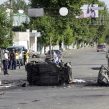
Kyrgyz Officials Blamed for Ethnic Unrest in Osh
Publication: Eurasia Daily Monitor Volume: 8 Issue: 87
By:

On May 2nd, a group of international experts presented their view of Kyrgyzstan’s violence in June 2010, which took the lives of 470 and displaced over 400,000 people. Finish MP Kimmo Kiljunen reported findings of the Kyrgyzstan Inquiry Commission (KIC) in Bishkek, summarizing over five months of research and 750 interviews (https://www.k-ic.org/images/stories/kic_report_english_final.pdf).
Political fanaticism, mixed with ethno-nationalism, was the main reason that violence sparked, the KIC concludes (www.fergana.ru, May 3). Most victims of the violence were ethnic Uzbeks, but “ethnic Kyrgyz also suffered very significant losses.” Murder, rape, torture and other forms of violence during and after the conflict remain underreported, the KIC reports. Since the conflict’s end, “roughly “80 weapons and about 19,000 rounds of ammunition have not been recovered,” which is of particular concern.
Among the most important findings was the KIC’s conclusion that Kyrgyzstan’s military and government officials were largely ineffective in stopping the violence and preventing the illegal capture of its ammunition by conflicting parties.
“The Commandant of Osh city and province, Bakyt Alymbekov, unlawfully abdicated control over law enforcement in favor of General Isakov and failed in his duty to ensure that human rights were respected during the restoration of order”, the report states. Furthermore, the KIC says that Kubatbek Baibolov, the former Prosecutor General, “failed to ensure that the investigation and prosecution of crimes committed” during the conflict, while Osh Mayor Melis Myrzakmatov fueled inter-ethnic tensions with his nationalist rhetoric.
Weeks before Kiljunen released the report, Kyrgyz political leaders tried to dismiss the KIC’s credibility. That the commission is biased, its members will become easy victims of rumors and the report will spark new ethnic clashes have been some of the major arguments against the investigation.
At a press-conference, Kiljunen also mentioned that the Kyrgyz government did not hinder the investigation. The then interim president Roza Otunbayeva mandated the commission to conduct an investigation shortly after the June 2010 conflict.
Since the June 2010 violence, former members of the interim government have not accepted responsibility for the bloodshed, instead preferring to blame a variety of forces—from pro-Bakiyev forces to Islamic extremists and organized crime. In all of the explanations, the government tried to argue that violence was carefully organized and premeditated. Indeed, these views were supported by some international observers in the wake of the conflict as well. The KIC’s report found no evidence of such “third forces” participating in the conflict, however.
Rather, the KIC report argues that ethnic tensions in Kyrgyzstan began on April 7, the day when former president Kurmanbek Bakiyev was ousted. “Power vacuum and consequent political rivalries, fragile state institutions and the weak rule of law in southern Kyrgyzstan” contributed to the unrest, the KIC report says.
According to Kiljunen, the June 2010 violence had elements of crimes against humanity, but was not genocide, as some Uzbek nationalists portray it (www.akipress.kg, May 2).
There is widespread confusion in defining the ethnic Uzbeks’ status in the country. Often, the minority group is mistakenly referred to as a diaspora, which has a choice of staying in Kyrgyzstan or moving to its “historic motherland”—Uzbekistan. Few people realize that ethnic Uzbeks are a part of the local population, just as much as the ethnic Kyrgyz and several other ethnic minorities. The KIC report thus suggests granting greater freedoms to the ethnic Uzbek minority, including recognizing the Uzbek language in southern parts of Kyrgyzstan.
Lack of public discussion and understanding of the concept of citizenship is another major issue Kyrgyzstan needs to tackle in the wake of ethnic violence. For most ethno-nationalists in the country, granting equal rights to ethnic Uzbeks is linked to fears of calls for Uzbek autonomy. The KIC report, however, found that rumors of the ethnic Uzbek minority’s wish for state autonomy are largely inflated.
Although the KIC’s conclusions might fall flat for some chauvinistic crowds in Kyrgyzstan, the report nevertheless contributes to public knowledge about violence. It might be able to kill rumors, as Kiljunen had envisioned as the investigation’s mission, and it is yet another step forward to a more frank and open discussion about what happened last year.
Some of the KIC’s findings correlate with those concluded by the National Commission, composed of Kyrgyz government members, NGO leaders and academics. Yet, Kiljunen’s report has a more detailed documentation of the events of June 2010 as well as a more elaborated methodology. The KIC is also significantly more assertive in criticizing Kyrgyz officials.
One important element missed by the KIC and other international observers is the fact that Kyrgyz military and police forces are not trained to deal with inter-ethnic tensions. To a large extent their views about ethnic Uzbeks are shaped by their understanding of Uzbekistan’s policy towards Kyrgyzstan. All too often, military and police officials see ethnic Uzbeks as the embodiment of a potential risk of military invasion by President Islam Karimov’s regime.
Such views prosper due to Kyrgyzstan’s lack of adequate military might combined with ethno-nationalism among military and police personnel. Indeed, according to the latest reports, Uzbekistan has been pulling its troops to the border with Kyrgyzstan, urging president Roza Otunbayev to convene security officials for an urgent meeting (www.km.ru, May 4).




